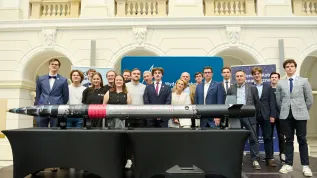
International students now account for more than 7.3 percent of the total number of students enrolled in Poland, according to a new report.
The report 'Foreign Students in Poland 2022’, is based on unpublished data from the Central Statistical Office for the academic year 2021/2022, data from the Integrated System of Information on Higher Education and Science POL-on, own research by the Perspektywy Education Foundation, and data from the OECD, UNESCO, and Project Atlas.
The report said: “In the academic year 2021/2022, 89,420 foreign students from 180 countries studied in Poland, which is 4,731 more than in the previous year (a 5.6% increase). International students now account for more than 7.3 percent of the total number of students in our country.”
It shows that 13 years ago there were only 0.82 percent of them, and in the academic year 2016/17 - 4.88 percent. The upward trend has continued since 2005.
The Polish Press Agency asked Dr. Bianka Siwińska, the President of the Perspektywy Education Foundation, if the number of over 89,400 foreign students studying at Polish universities also included students studying remotely, living outside of Poland.
She said: “Of course, some students receive their education online, but the official statistics do not have the relevant data - they do not analyse this phenomenon. There are only rough, partial data. For example, incomplete data collected by the Conference of Rectors of Academic Schools in Poland show that about 10 percent of first-year students from Ukraine study remotely; this mainly applies to conscript-age men unable to cross the border.”
For years, Ukrainians have been the largest group of foreign students in Poland. However, their number has begun to decrease. Dr. Siwińska points out that the number of students from Ukraine at Polish universities has been decreasing since the academic year 2018/19, when it reached its peak (39,203 people).
She said: “This is natural because Ukraine, like Poland, is in a period of demographic decline, especially in the age group 17-25. The influence of the war is also significant, although it is not clearly negative, as some of the youth from Ukraine who previously would study in Russia probably came to Poland - about 7,000 people.”
The report also shows that the number of students from Africa is increasing.
According to the analysis, despite an increase in the number of international students in recent years, the proportion of such students studying in Poland is still lower than in the most developed OECD countries and in China.
The report said: “Our neighbours also have more international students: Czechia, Hungary, Slovakia and Lithuania. Poland remains one of the least internationalised countries in the European Union and OECD.
Dr. Siwińska added that the main constraint on the number of students in Polish universities is visa policy.
She said: “Universities, organizations that support them and information and promotional programmes, such as +Study in Poland+, already know well where to look for university candidates and how to effectively recruit them. However, one must have a visa to come to Poland.
“And here lies the problem, because visas are issued by a different department. For several years now, for example, we could have had 8-10 thousand students from India, but consular services effectively blocked it.”
In conclusion, the authors write that we should expect further increases in the number of international students at Polish universities.
Dr. Siwińska said: “Our optimism is based on the development of new recruitment markets, such as Uzbekistan, a country from which only 340 students came to Poland five years ago, and now there are nearly 10 times more! To reinforce this positive trend, CRASP (the Conference of Rectors of Academic Schools in Poland - ed. PAP) and the Education Foundation Perspektywy are organizing large Presentations of Polish Universities in Tashkent and Samarkand in April, preceded by the first Forum of Rectors of Poland and Uzbekistan, also in Tashkent. The launch of a direct air connection Warsaw-Tashkent in March will be an excellent convenience for the development of bilateral educational and scientific cooperation between our countries.”
The 13th edition of the report was published in February as part of the 'Study in Poland' programme that promotes Polish universities abroad. 'Study in Poland' is a joint programme of CRASP and the Education Foundation Perspektywy. (PAP)
PAP - Science in Poland, Szymon Zdziebłowski
szz/ mir/ kap/
tr. RL













